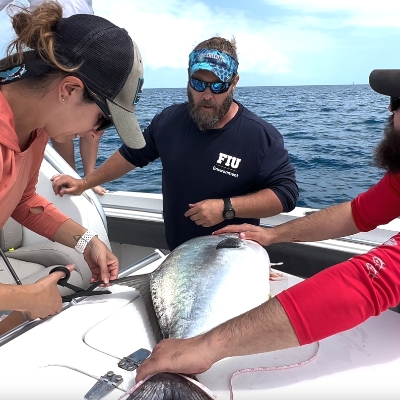Permit Spawning Aggregation Dynamics in the Florida Keys
Research Team
Project Overview
The purpose of this research is to monitor permit spawning aggregations on natural and artificial reefs in the Florida Keys, collecting data on aggregation size and distribution, fishing pressure, and depredation mortality.
Duration of Project
2018 - 2024
Expedition Summary
From March 4-13th, 2023, The International SeaKeepers Society assisted researchers from Florida International University, supported by Bonefish & Tarpon Trust, in conducting research on permit (Trachinotus falcatus) spawning aggregations in the Lower and Middle Florida Keys. Permit aggregate on natural and artificial reefs in the Keys surrounding the full moons from March through June each year. Catch-and-release angling for permit during their spawning season has become a popular sport fishery for many anglers, and, although not inherently detrimental to the fishery since permit harvest is prohibited between April 1 and July 31 throughout the Florida Keys, depredation (i.e., the removal of hooked fish by a predator) has produced a high level of concern regarding the sustainability of this practice.
As a result, Florida Fish and Wildlife Conservation Commission implemented a seasonal fishing closure from April 1 – July 31 each year at Western Dry Rocks, where depredation mortality has been historically high, to protect permit and other species that aggregate here. To evaluate the efficacy of this closure and monitor other fished aggregation sites throughout the Florida Keys, we used a combination of active acoustics (multi-beam imaging sonar), video (360° and line-cameras), and hook-and-line fishing surveys to collect data on permit school size and individual size. Observational data on fishing pressure (i.e., number of fishing boats, time spent fishing) and depredation rates (i.e., number of angled permit lost to sharks) at openly fished sites were also collected.
Some highlights from data collected on this trip:
- Fishing pressure was consistent at sites in the Middle Keys with 3-5 boats spending 0.25-2 hrs fishing for permit. At sites in the Lower Keys, we did not observe any boats targeting permit throughout the duration of our survey.
- We observed sharks across all sites, including bull (Carcharhinus leucas), sandbar (C. plumbeus), Caribbean reef (C. perezi), and great hammerhead (Sphyrna mokarran) sharks, as well as depredation events, which occurred at the surface, were communicated by charter captains, or were recorded by line camera footage.
- Our initial results from the combined acoustic and video data suggest that abundance ranged from 1-300 individuals at all sites where permit aggregations were observed, despite March being considered early season for permit spawning.
- The range of permit sizes captured was consistent with site-specific data from previous years, where Middle Keys fish were noticeably smaller than those in the Lower Keys.
- We also observed large aggregations of crevalle (Caranx hippos) and horse-eye jacks (C. latus) at several sites during our surveys.
Application
The data collected on this trip will be used to assess seasonal and annual variation in permit spawning aggregation density and distribution across several sites in the Lower and Middle Florida Keys. Moreover, the observational data from this trip will be used to quantify recreational fishing effort and associated depredation rates at openly fished sites, which is critical in understanding the extent of depredation mortality and its effect on permit spawning aggregation dynamics.
Location
Key West, Florida
Media

